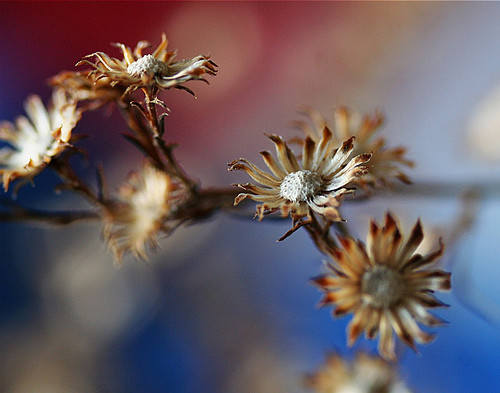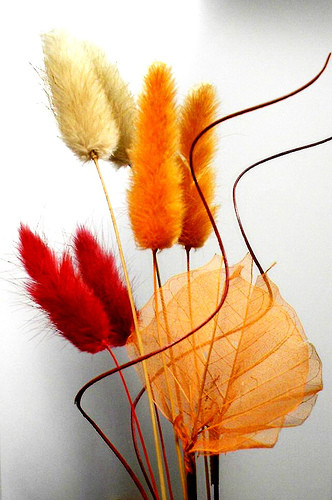 Dried flowersBut you can extend the summer.All you need for this is a vase with dried summer flowers. Such compositions, created on the basis of dried plants, are called winter bouquets. Not only dried flowers are suitable for winter bouquets, but also leaves and even stems with seed heads. The choice of plants for such bouquets is limited by certain requirements. First of all, plants are selected that can retain their original appearance when dried, both annuals and perennials. Various types of amaranth, celosia, helichrysum, gomphrena, limpet (statice) are suitable. However, in addition to annuals, perennial herbaceous plants can also be used in dry bouquets - different types of yarrow, gypsophila, eryngo, echinops.
Dried flowersBut you can extend the summer.All you need for this is a vase with dried summer flowers. Such compositions, created on the basis of dried plants, are called winter bouquets. Not only dried flowers are suitable for winter bouquets, but also leaves and even stems with seed heads. The choice of plants for such bouquets is limited by certain requirements. First of all, plants are selected that can retain their original appearance when dried, both annuals and perennials. Various types of amaranth, celosia, helichrysum, gomphrena, limpet (statice) are suitable. However, in addition to annuals, perennial herbaceous plants can also be used in dry bouquets - different types of yarrow, gypsophila, eryngo, echinops. Echinops, especially the non-flowering one, does not haveany significant decorative value, in addition, its leaves are quite prickly. At first glance, this is a real weed, but do not jump to conclusions. By mid-summer, unusual, spherical inflorescences appear, often blue (less often white), decorating the garden with their original appearance for a long time. Echinops is very unpretentious, long-lived, easily propagated by both seeds and by dividing the bushes in spring or autumn. Eryngiums are openwork plants, and the haze of their blue flowers, collected in capitate inflorescences, is unlikely to leave anyone indifferent. Meadowsweet yarrow will add a yellow gamut to a winter bouquet. However, in addition to yellow-flowered forms, there are species of yarrow with white, pink and almost red shades of inflorescences. Yarrows are more than unpretentious, grow well in poor and dry soils. They reproduce both by seeds and vegetatively - by dividing the bushes in spring or autumn. Gypsophila will serve as an unusual background for any composition. Its delicate small white or pink flowers are collected in large paniculate inflorescences. Gypsophila is also an unpretentious plant, but it does not tolerate excessively wet soils, as well as frequent divisions and transplants. It is best to reproduce it by seeds. Gypsophila is short-lived, so you need to take care of sowing young plants in advance.
Echinops, especially the non-flowering one, does not haveany significant decorative value, in addition, its leaves are quite prickly. At first glance, this is a real weed, but do not jump to conclusions. By mid-summer, unusual, spherical inflorescences appear, often blue (less often white), decorating the garden with their original appearance for a long time. Echinops is very unpretentious, long-lived, easily propagated by both seeds and by dividing the bushes in spring or autumn. Eryngiums are openwork plants, and the haze of their blue flowers, collected in capitate inflorescences, is unlikely to leave anyone indifferent. Meadowsweet yarrow will add a yellow gamut to a winter bouquet. However, in addition to yellow-flowered forms, there are species of yarrow with white, pink and almost red shades of inflorescences. Yarrows are more than unpretentious, grow well in poor and dry soils. They reproduce both by seeds and vegetatively - by dividing the bushes in spring or autumn. Gypsophila will serve as an unusual background for any composition. Its delicate small white or pink flowers are collected in large paniculate inflorescences. Gypsophila is also an unpretentious plant, but it does not tolerate excessively wet soils, as well as frequent divisions and transplants. It is best to reproduce it by seeds. Gypsophila is short-lived, so you need to take care of sowing young plants in advance. In addition to the colorful blooming plants in winter bouquetsWe must not forget about cereals. Their graceful inflorescences, although not very flashy, create a feeling of elegance and completeness of almost any composition. For dry bouquets, the most interesting are various feather grasses, which have light, almost weightless openwork inflorescences; miscanthus with large paniculate inflorescences of an unusual silvery-white color; briza with loose, but very graceful spreading panicles; reed grass with dense fluffy "brooms"; crested barley; feathery setae; setae. We should not forget about dried seeds. Thus, mother-of-pearl lunaria pods, bright orange lanterns or relief poppy seed pods will look absolutely incomparable in winter bouquets. And even large umbrellas of such a malicious weed as hogweed create a completely unusual, I would say, monumental composition, although it is more suitable for large spaces.
In addition to the colorful blooming plants in winter bouquetsWe must not forget about cereals. Their graceful inflorescences, although not very flashy, create a feeling of elegance and completeness of almost any composition. For dry bouquets, the most interesting are various feather grasses, which have light, almost weightless openwork inflorescences; miscanthus with large paniculate inflorescences of an unusual silvery-white color; briza with loose, but very graceful spreading panicles; reed grass with dense fluffy "brooms"; crested barley; feathery setae; setae. We should not forget about dried seeds. Thus, mother-of-pearl lunaria pods, bright orange lanterns or relief poppy seed pods will look absolutely incomparable in winter bouquets. And even large umbrellas of such a malicious weed as hogweed create a completely unusual, I would say, monumental composition, although it is more suitable for large spaces.

Making Money with Desserts: Success Stories
Evgeniya Polischuk (Fedutinova) instagram:@evgeniyafedutinovavk.com/janeshomebaking– It all started with baking for family and friends. Gradually, I started posting photos of my baked goods on Instagram – and orders started coming in. I made my first custom-made cake on October 13, 2014, and a little earlier I started making macaroons and cupcakes. You could say that the business “found me”, I am very […]

Soups are cold recipes with photos
Cold cucumber soup with yogurt and lemonsorbet from the chef of the restaurant La Taverna Alexander Zhurkin Photo: Getty Images Ingredients: Plain yoghurt – 125 g Cucumber – 150 g Lemon/lime sorbet – 50 g Cocktail shrimp – 24 g Fresh ginger juice – 1 g Lime juice – 5 g Fresh orange juice – 5 g Parsley – 1 g Pink pepper – 1 g Watercress – […]

barbeque kebab
Pork tenderloin in glaze Photo:Dmitry Bayrak/dbstudioPreparation time: 20 minutes + marinating time.Calories: 454 kcal per serving.For 4 servings: 4 pork tenderloins (approximately 300 g each), 1 onion, 2 cloves of garlic, 1 tsp. lemon zest, 1 tsp. lemon juice, a pinch of ground cumin, coriander and turmeric, 1 tbsp. vegetable […]

Pierre Duacan: dietary recipes: Ducane diet
Beetroot soup Photo:Season’S, Luxury Hotels RepresentationYou will need:· Boiled beetroot – 60 g· Fresh cucumbers – 20 g· Red radish – 20 g· Green onions – 10 g· Egg – 1 pc.· Drinking mineral water – 200 g· Salt – 1 gPreparation:· Boil the egg and beetroot.· Grate the cucumbers, radish and part of the beetroot. Put everything […]





